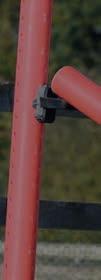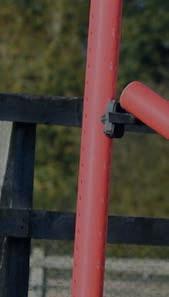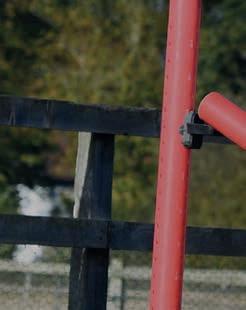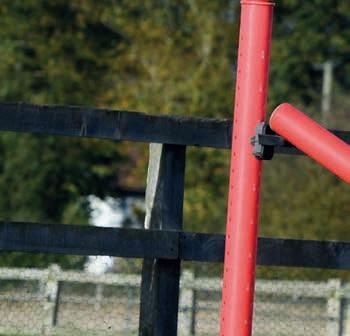















































































































































WWinter doesn’t mean you have to stop perfecting your cross-country skills, and by practising them in the arena you can have a head start before the season gets under way! Check out how to recreate three types of XC fences in the school – but watch out, they get trickier as you climb the levels. Can you ace them all?
Be sure to tailor your warm-up period to get your pony in the cross-country zone! Practise riding in two-point position in canter along the long side to encourage him to open up his stride, and incorporate lots of transitions between and within paces to get him moving off your leg and listening to your aids.



A rail-ditch-rail combination is exactly what it sounds like – a fence, followed by one or two strides to a ditch, then one or two strides to another rail. On a cross-country course, they often involve a change of terrain, such as downhill to the ditch then uphill to the last rail, so they can be a bit spooky.
You’ll need four blocks, six poles and a tarpaulin for your rail-ditch-rail combination. To create the ditch, place the tarpaulin sheet on the ground near E or B and pop two poles on it to secure it. Then set up two uprights, one either side of your ditch, with a one-stride distance (6.1–7.3m) between each element.



Your pony may not spot the ditch until he’s jumping the first rail, so allow with your hands to let him lower his head and look at what’s ahead of him. Aim to approach in a really positive canter and try counting your strides out loud to keep the rhythm. Sitting up between the elements is really important, too, because leaning forward will disrupt your pony’s rhythm and balance.















Improve your pony’s showjumping technique with Pony Nuts!
There are loads of elements that make up the perfect showjumping round, from your pony’s canter rhythm to your balance in the saddle, and working on all aspects will give you the best chance of success. But do you know how to improve your pony’s jumping technique? Here are my three fave exercises that’ll do just the job.

Position your fence down the long side of the arena, making sure you can approach it on both reins so your pony works evenly.

































Be sure your pony is thoroughly warmed up before trying these exercises. It’s important that he’s responsive to your aids and working actively.





Aim of the game: Cross-poles are great for getting your pony to work on his straightness, not only on the approach and get away, but also as he bascules over the fence. The middle of the cross gives you a point to aim for, too, which is helpful!








Set it up: You’ll need two wings or blocks and two poles – start by keeping the cross-pole small. How to ride it: Cross-poles are inviting for ponies, but that doesn’t mean you can switch off and let him do all the work. Remember to think about your approach, allowing plenty of time to find your straight line to the middle. Channel your pony by pressing with both legs and keeping an even contact down both reins. Keep your eyes up and focused on a marker the other side of the fence.
Take it to the next level: When you’re ready, have a go at high-sided cross-poles – they’ll give your pony extra encouragement to keep his body straight and tuck up his legs when jumping. Always increase the height gradually.




Aim of the game: V-poles are perfect for encouraging your pony to jump carefully because they act as a visual cue, like a filler, to ask him to lift his front end higher and stretch his head and neck down. Set it up: Change your fence into an upright and then place a pair of extra poles with one end on the jump and the other on the floor to create an upside-down V. Keep the V wide to start with.
How to ride it: Some ponies can find V-poles off-putting or spooky, but by keeping your leg on and the poles extra wide at first, he’ll get the hang of them in no time. Channel him straight towards the middle of the fence, like you did with the cross-poles, then be ready for your pony to jump a little bigger as he works harder to be more careful – allowing with your hands and lifting yourself out of the saddle to follow his movement.
Take it to the next level: As you feel more confident, slowly bring the poles closer together until they’re touching – this will help create a neater bascule.





















Learn all about the daily routine of a Redwings rehoming pony! a

7.30am
7.30am
As soon as the rehoming team arrive at the yard, it’s time for the ponies to have their breakfasts!

While the ponies enjoy time in the field, the team get to work – mucking out stables, making haynets and putting in fresh bedding – before sitting down for a well-deserved tea and biscuit break!
Alot of effort goes in to getting a rescue pony ready to be rehomed and the team at Redwings pay close attention to combining training time with making sure the ponies live happy, healthy lives. Here’s what a pony at Redwings gets up to each day…
8.15am
8.15am

When all the ponies are fed, they’re checked over from nose to tail to make sure they’re happy and healthy before being turned out in the field – if a pony has an injury or any lumps or bumps, he’ll be visited by the vet before going out with his pals.
Once in the field, the team deliver the ponies some hay or haylage, which is especially important for them in winter when there isn’t much grass!
The Redwings night team carry out checks on all the residents to make sure they’re safe and well. This special team is super-important at the Redwings Horse Hospital because they’re responsible for giving feed and medication to patients all through the night – there are vets on hand, too, in case of emergencies.
10.30am
10.30am
It’s training session time! The type of activity depends on how far along the ponies are in their training and whether they’re being rehomed as non-ridden companions or unbacked projects.
Ponies in early stages of training will come in from the field to be groomed or spend time in the arena working on their basic responses –such as being taught to stop, lead and park.


Other ponies will be introduced to tack or go for in-hand hacks around the Redwings farm. This is a really valuable part of their training –they might come across tractors, dog walkers using the public footpaths, and lots of other things they could encounter in their new homes one day!
11.30am 11.30am









11.30am
Once training sessions are complete, it’s back to the field for lunchtime!
did you know?did you know?
Most of the ponies at Redwings live out 24/7 with access to a field shelter, but any pony in the process of being trained and rehomed stays in a stable at night. This is to make sure he will be happy if stabled at his new home!

1.30pm
During the afternoon, the team carries out lots of different management jobs – including making sure the fields are poo-picked, safe and tidy – as well as hosting trials between ponies and possible future guardians.
Some ponies will be seen by the farrier and others, who have completed their training, might get checked over by a Redwings vet for their final sign-off before going to new homes.
3.30pm
The team will make sure the ponies’ stables are ready for when they come in by fluffing up the shavings to make everything cosy! Once the ponies have been brought in from the field, they’ll have their feet picked out and receive a haynet each for dinner.
Before the team leave at the end of the day, they do a final check to make sure the ponies are happy and write down any important notes for the night team.
